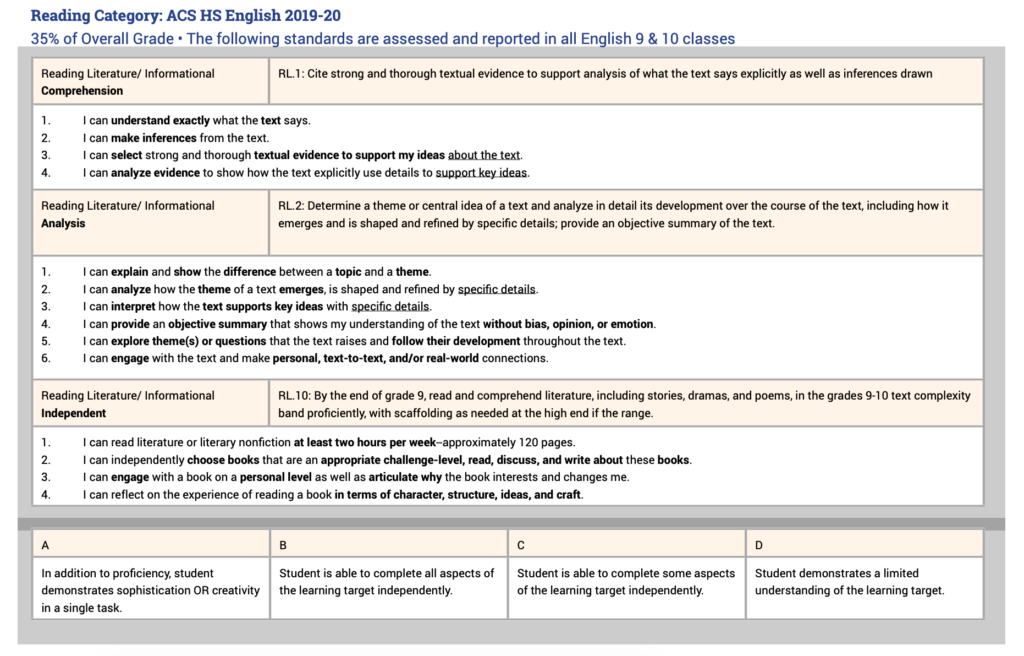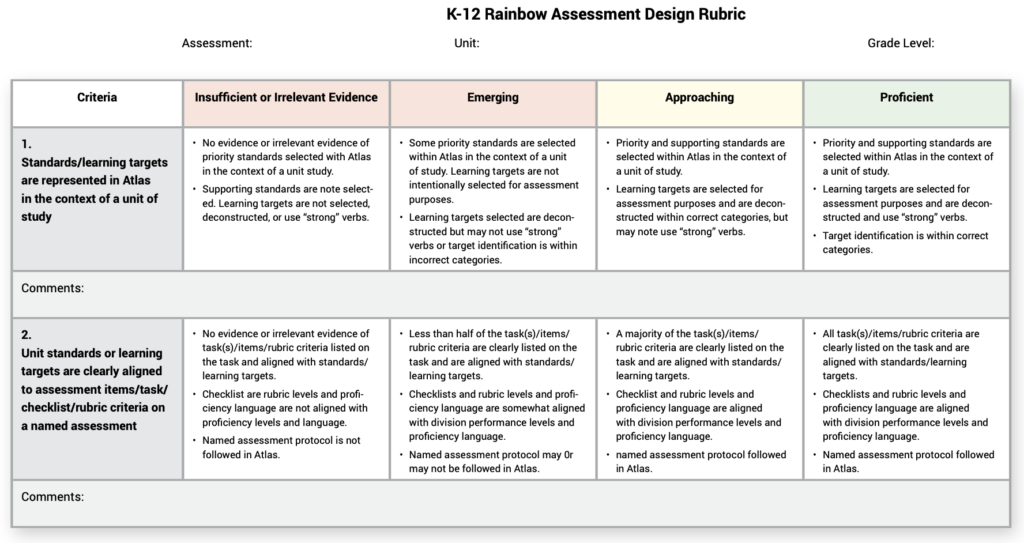Written by Andrea Fossum, Director of Learning, American Community School, Amman
The American Community School Amman in Jordan is dedicated to providing students with high standards in teaching and learning, as well as fostering a rich culture of collaboration. To support this work, over the last seven years ACS Amman has adopted new standards in every subject area. Throughout the adoption process, teachers have used the Atlas online curriculum mapping tool to ensure vertical articulation of content and skills across grade levels and divisions and to collaborate on shared courses. As teachers worked to build alignment within the curriculum, they also participated in dynamic collaboration through the systemic integration of professional learning time and common planning.
Cultivating a Collaborative Culture
The teachers at ACS Amman have been actively engaged in professional learning concerning assessment design, implementation of the new standards, and effective analysis of student data to inform personalized learning and program development. To support this work, ACS Amman adopted the Solution Tree model of Professional Learning Communities at Work (PLC) as a framework for reviewing curriculum maps, lesson plans, assessments, and student work. The aggregate results of teacher professional development, the use of the Atlas platform, and the application of the PLC Four Essential Questions helps us achieve “the moral imperative of our profession [to] ensure high levels of learning for each student in our collective care” (DuFour, et. al 2016, p. 257).
To facilitate this, K-12 Subject Area Teams meet once a month for 75 minutes during all school professional development time. At the secondary school level, teachers within the same subject area have 75 minutes of common planning every other day. Grade level teams meet once a week for 60 minutes during Core Collaborative Time to discuss students of concern with the learning support teachers and engage in specific professional learning. Senior Administrators also carefully consider professional development for faculty when crafting new initiatives to meet strategic performance objectives.
Supported by Academic Research and Design
Atlas and the PLC Four Essential Questions are based in academic research and designed for practical implementation. Curriculum maps create an intellectual workspace through which teachers engage in planning and reflection, shared leadership and practice, collaborative inquiry, accountability, and relationship building (Carpenter, 2017). Atlas specifically enables teachers to engage in cooperative planning through the interactive nature of the template and the Communication Channel feature. The PLC framework creates “an avenue to guide teachers through this process...[and] develop a sense of intentionality and increased self efficacy” (Reina, 2018, p. ii). As teachers move through the process of collective inquiry using the PLC Four Essential Questions and documenting their work in Atlas, they publicly reflect on practice, share their understandings to develop collective meaning, and coordinate their actions (Ross, Smith & Roberts, 1994).
At ACS Amman, we use the traditional curriculum map template based on the Understanding by Design framework created by Wiggins and McTighe (2005) to organize our thinking, planning, and implementation in common stages as we backward design student learning. The PLC Four Essential Questions complement these stages because of their guiding focus on what students know, can do, and how we as educators respond when they require support or enrichment. Atlas provides the organization tool for answering these questions:
- What do we want all students to know and be able to do?
- How will we know if they learn it?
- How will we respond when some students do not
learn?
- How will we extend the learning for students who
are already proficient? (DuFour et al., 2016).
The PLC Four Essential Questions in Practice
Understanding the crosswalk between Atlas and the PLC Four Essential Questions is important to holistic instructional design. Amy Foley (2018), Innovation Institute Coordinator & 6-12 Science Instructional Coach at Shanghai American School, applies the UbD-PLC-NGSS crosswalk with her science teams to make the process visible to teachers as they design phenomena based learning (2018). The National Council of Teachers of Mathematics offers a series of books aligning the PLC at Work approach (DuFour et al., 2016) with Common Core Math standards. ACS Amman integrates a similar approach, aligning the PLC Four Essential Questions with the Atlas template (Figure 1).
Figure 1. Crosswalk between PLC Four Essential Questions and Atlas curriculum mapping template
PLC Question 1 and Atlas Stage 1: Desired Results
The third grade team at ACS Amman is adept at using the PLC Four Essential Questions to guide their examination of student work. Student results from diagnostic, formative, and summative assessments in all three grade level sections are placed in a shared spreadsheet and color coded to show which students earned “3 Proficient” (green), “2 Approaching” (yellow), and “1 Emerging” (red). In their weekly meetings, teachers review this quantitative data against the standards and learning outcomes outlined in Stage 1 of the collaborative Atlas curriculum map to see which objectives need to be revisited by which students and to what extent. Should a preponderance of students score a 2 or below on a particular learning target, teachers revisit the aligned assessment for possible redesign.
Over the last three years, the third grade team has had at least one new person each year due to the typical turn over in international schools. The Atlas curriculum map is critical to maintaining continuity of instruction and program alignment. Additionally, the PLC framework provides the protocols for quickly assimilating new members as equal partners in designing student learning.
PLC Question 2 and Atlas Stage 2: Evidence
In the high school, Grade 10 English Language Arts (ELA) teachers design common mark schemes and rubrics that reflect the Stage 1 standards and learning targets in each unit.
This Stage 2 Assessment Evidence rubric is referenced by teachers as they collaboratively review student essays. During the review, teachers assess the alignment of the rubric with the learning targets. These qualitative observations are then corroborated with the entire ELA team. Any changes to rubrics are uploaded in Stage 2.
Focus on Learning
The middle school ELA Team follows a similar process, delving into qualitative data to uncover aspects of student performance that may not be readily evident in the stages of the curriculum map. Recent discussions about 6th grade student work revealed that mood and tone were an issue to be addressed. A review of the Stage 1 and Stage 2 curriculum map indicated that the standards and assessment methods were congruent and aligned with the CCSS. As one teacher noted, as they “peeled the layers of the onion,” they discovered that the problems with understanding mood were grounded in a lack of vocabulary, and the issues with tone reflected a lack of understanding about punctuation. This example from Harry Potter and the Goblet of Fire (Rowling, 2000) illustrates their findings:
The usual confusion and noise filled the corridors as the students began to disembark. Ron and Hermione struggled out past Malfoy, Crabbe, and Goyle, carrying their trunks. Harry, however, stayed put. “Fred — George — wait a moment.” The twins turned. Harry pulled open his trunk and drew out his Triwizard winnings. “Take it,” he said, and thrust the winnings into George’s hand (p. 616).
The words Rowling used to set the mood, e.g. “confusion” and “thrust,” were noted as problematic for students, and they were unable to incorporate the pauses denoted by the em dashes because they did not recognize that punctuation. Recognizing this, one of the teachers read the passage aloud during a visible thinking routine, explaining to the students why she paused and chose certain inflection for words to convey the tone of the scene.
Next, the teachers used Atlas to revisit the vertical alignment of skills and practices, looking specifically at Grade 5 ELA units. They noted that the curriculum used in elementary does not specifically teach conventions, and that target vocabulary may emerge in word study and word walls, but may require additional scaffolding. The middle school teachers included these insights in their Stage 4 Reflection and shared their observations during a monthly ELA Subject Area Team meeting.
PLC Questions 3 & 4 and Atlas Stage 3: Building Interventions Through the Learning Plan
ACS Amman’s Student Services department addresses issues that may arise from PLC Questions 3 and 4 — “How will we respond when some students do not learn?” and “How will we extend the learning for students who are already proficient?” — as they co-plan daily learning with classroom teachers in Stage 3. Learning support teachers meet with classroom teachers twice in an eight day cycle of classes to review Stages 1 and 2 and co-design the intervention and assessments for struggling students and for students who are proficient and beyond. Classroom teachers and student support teachers compare assessment data sheets and progress monitoring for horizontal correlation across subject areas as well as adherence with students’ individual learning plans. While these interventions are not documented in Atlas due to the highly personalized nature of the accommodations and assessments, the curriculum map provides a shared third point to reference during teachers’ collective discourse (Thinking Collaborative, 2019).
Looking Ahead
ACS Amman recognizes that there are many emergent opportunities present in the curriculum mapping tool on the Atlas platform that can deepen our PLC discussions. For example, making more intentional use of the Communications Channel between grade levels and subject areas may identify entry points for designing transdisciplinary units. Our customized “Stage 4: Reflection” section could also be used more intentionally to note future changes and adjustments. Finding ways to adapt non-traditional curricular mapping into Atlas is also an aspirational goal. Overall, teaching teams appreciate the PLC Four Essential Questions as a framework for collective dialogue concerning student learning and recognize the myriad ways that Atlas “provides a venue for problem solving throughout the collaborative inquiry process [to] transform pedagogical practices in the shared workspace” (Carpenter, 2017, abstract).
You can read more articles like this in our new Curriculum Magazine:
Before joining The American Community School in Amman, Andrea was the Assistant Principal for Curriculum, Instruction and Assessment at The American School Foundation of Monterrey. She also worked at the International School of Islamabad (Pakistan) as the Secondary Principal as well as a K-12 Librarian and Secondary History teacher. While at ISOI, Andrea was also involved in NESA as a member of the Wider Circle.
References
Carpenter, D. (2017). Collaborative inquiry and the shared workspace of professional learning communities. International Journal of Educational Management, 31(7), 1069-1091, doi:10.1108/IJEM-10-2015-0143
DuFour, R., DuFour,R., Eaker, R. Many, T.W. & Mattos, M. (2016). Learning by doing: A handbook for Professional Learning Communities at Work. Bloomington, IN: Solution Tree.
Foley, A. (2018, October 21). NGSS UbD Unit Planning Cycle for PLCs (Collaborative Teams).
Teaching is Learning. Retrieved from https://teachingislearningsite.wordpress.com/2018/10/21/ngss-ubd-unit-design-for-plcs/ Reina, L.J. (2018). Route-finding: Developing curricular knowledge and impacting practice through a collaborative curriculum mapping process. ProQuest Dissertations and Theses. (AAT10974498)
Ross, R. Smith, B., & Roberts, C. (1994). The team learning wheel. In Senge, P. et al., The fifth discipline fieldbook: Strategies and tools for building a learning organization (pp. 59-64). New York: Doubleday.
Rowlings, J.K. (2000). Harry Potter and the Goblet of Fire. London: Bloomsbury.
Thinking Collaborative. (2019). Using a third point in a calibrating conversation. Retrieved from https://www.thinkingcollab-orative.com/stj/point-cali-brating-conversation/
Wiggins, G. & McTighe, J. (2011). The Understanding by Design guide to creating high quality units. Alexandria, VA: Association for Supervision and Curriculum Development.





